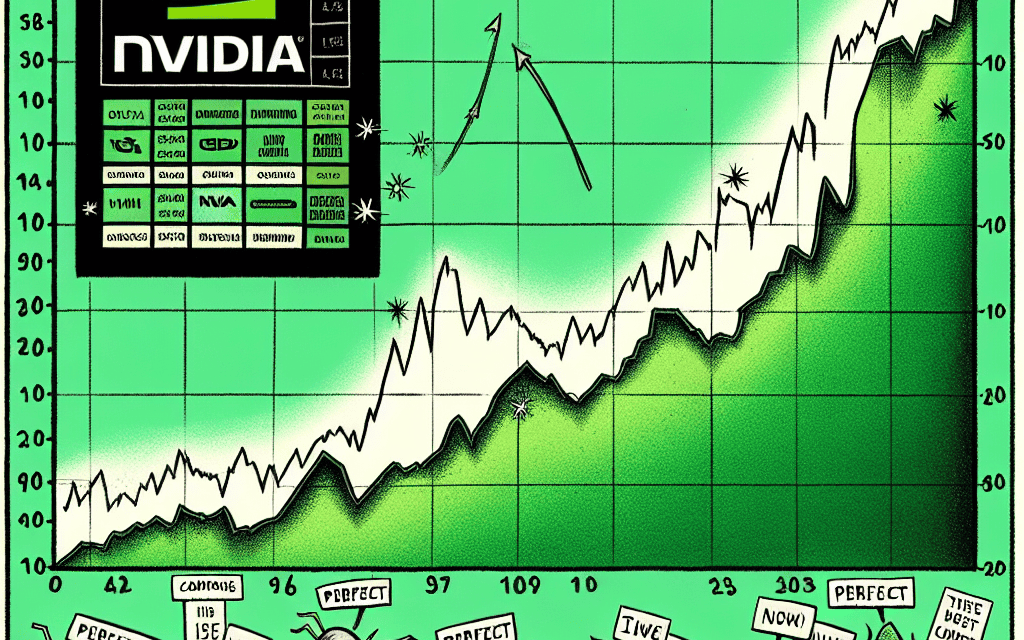“Nvidia: Once Flawless, Now Facing the Test of Time.”
Introduction
Nvidia, a leading player in the semiconductor industry, has been recognized as one of the 15 ‘perfect’ stocks due to its robust financial performance and innovative advancements in graphics processing technology. The company’s dominance in the GPU market, driven by its pivotal role in powering AI, gaming, and data center applications, has positioned it as a key growth stock. However, recent analyses suggest emerging blemishes that could impact its pristine status. These include potential market saturation, increased competition, and geopolitical tensions affecting supply chains. As Nvidia navigates these challenges, investors are closely monitoring its strategic responses to maintain its esteemed position in the tech sector.
Nvidia’s Market Position: Analyzing Its Strengths and Weaknesses
Nvidia has long been heralded as a titan in the semiconductor industry, consistently demonstrating robust growth and innovation. Its position as a leader in graphics processing units (GPUs) has been a cornerstone of its success, driving significant advancements in gaming, artificial intelligence, and data center operations. The company’s ability to adapt and innovate has placed it among the 15 ‘perfect’ stocks, a testament to its strong market position and investor confidence. However, as with any major player in a rapidly evolving industry, Nvidia is not without its challenges and potential vulnerabilities.
One of Nvidia’s most significant strengths lies in its dominance of the GPU market. The company’s GPUs are renowned for their performance and efficiency, making them the preferred choice for gamers and professionals alike. This dominance is further bolstered by Nvidia’s strategic partnerships and collaborations, which have expanded its reach into various sectors, including automotive and cloud computing. Moreover, Nvidia’s commitment to research and development has enabled it to stay ahead of the curve, consistently introducing cutting-edge technologies that set industry standards.
In addition to its technological prowess, Nvidia’s financial performance has been impressive. The company has reported strong revenue growth, driven by increased demand for its products across multiple sectors. This financial stability has allowed Nvidia to invest in new ventures and acquisitions, further solidifying its market position. For instance, its acquisition of Mellanox Technologies in 2020 enhanced its capabilities in data center networking, a critical area of growth as cloud computing and AI continue to expand.
Despite these strengths, Nvidia faces several challenges that could impact its future trajectory. One of the most pressing issues is the increasing competition in the semiconductor industry. Companies like AMD and Intel are making significant strides in developing competitive products, which could erode Nvidia’s market share. Additionally, the rapid pace of technological advancement means that Nvidia must continually innovate to maintain its leadership position, a task that requires substantial investment and carries inherent risks.
Another potential vulnerability for Nvidia is its reliance on specific markets. While the gaming industry has been a significant driver of Nvidia’s success, it is also subject to fluctuations in consumer demand and economic conditions. Similarly, the company’s expansion into AI and data centers, while promising, is not without its challenges. These sectors are highly competitive and require constant innovation to meet evolving customer needs and expectations.
Furthermore, Nvidia’s global operations expose it to geopolitical risks, such as trade tensions and regulatory changes. The semiconductor industry is particularly sensitive to such issues, given its reliance on complex supply chains and international markets. Any disruptions in these areas could have a significant impact on Nvidia’s operations and profitability.
In conclusion, while Nvidia’s strengths have positioned it as a leader in the semiconductor industry, it is not immune to the challenges and uncertainties that come with such a status. The company’s ability to navigate these challenges will be crucial in determining its long-term success. As Nvidia continues to innovate and expand its market presence, it must also remain vigilant in addressing potential vulnerabilities and adapting to an ever-changing industry landscape. This balance of leveraging strengths while mitigating weaknesses will be key to maintaining its position among the ‘perfect’ stocks in the years to come.
The Impact of Emerging Blemishes on Nvidia’s Stock Performance
Nvidia, a titan in the semiconductor industry, has long been celebrated for its innovative contributions to graphics processing and artificial intelligence. Recently, it was named among 15 ‘perfect’ stocks, a testament to its robust financial performance and strategic positioning in the market. However, as with any high-performing entity, emerging blemishes have begun to surface, potentially impacting its stock performance. Understanding these imperfections is crucial for investors and stakeholders who have placed their confidence in Nvidia’s continued success.
To begin with, Nvidia’s dominance in the graphics processing unit (GPU) market has been a significant driver of its stock’s stellar performance. The company’s GPUs are not only essential for gaming but also for data centers and AI applications, sectors that have seen exponential growth. This diversification has allowed Nvidia to capitalize on multiple revenue streams, thereby solidifying its position as a market leader. However, the very markets that have propelled Nvidia to the top are now presenting challenges that could affect its future trajectory.
One of the primary concerns is the increasing competition in the semiconductor industry. Companies like AMD and Intel are aggressively innovating and expanding their product lines, aiming to capture a larger share of the market. This intensifying competition could lead to pricing pressures, which may erode Nvidia’s profit margins. Furthermore, as these competitors enhance their technological capabilities, Nvidia may find it more challenging to maintain its technological edge, a factor that has been pivotal to its success.
In addition to competitive pressures, Nvidia is also navigating the complexities of global supply chain disruptions. The semiconductor industry has been particularly vulnerable to these disruptions, which have been exacerbated by geopolitical tensions and the lingering effects of the COVID-19 pandemic. These supply chain issues have led to component shortages and increased production costs, which could impact Nvidia’s ability to meet demand and maintain its growth trajectory. Consequently, investors are closely monitoring how the company manages these challenges to sustain its operational efficiency.
Moreover, regulatory scrutiny is another emerging blemish that could influence Nvidia’s stock performance. The company’s attempted acquisition of ARM Holdings, a deal that was ultimately abandoned, highlighted the regulatory hurdles that Nvidia faces as it seeks to expand its influence in the semiconductor industry. Regulatory bodies are increasingly vigilant about antitrust concerns, and any future attempts by Nvidia to pursue large-scale acquisitions may be met with similar resistance. This regulatory environment could limit Nvidia’s strategic options for growth, thereby affecting investor sentiment.
Despite these challenges, it is important to recognize that Nvidia remains a formidable player in the industry. The company’s commitment to research and development continues to yield cutting-edge technologies that drive innovation across various sectors. Additionally, Nvidia’s strategic partnerships and collaborations position it well to explore new opportunities and mitigate some of the risks associated with its emerging blemishes.
In conclusion, while Nvidia’s status as a ‘perfect’ stock is being tested by emerging blemishes, the company’s resilience and adaptability should not be underestimated. Investors and stakeholders must remain vigilant, keeping a close eye on how Nvidia navigates these challenges. By doing so, they can make informed decisions about the company’s potential for sustained growth and its ability to maintain its esteemed position in the market.
Nvidia’s Role in the Semiconductor Industry: Opportunities and Challenges
Nvidia has long been a dominant force in the semiconductor industry, renowned for its cutting-edge graphics processing units (GPUs) that have revolutionized gaming, artificial intelligence, and data processing. As one of the 15 ‘perfect’ stocks identified by market analysts, Nvidia’s position in the industry is both a testament to its innovative prowess and a reflection of the growing demand for advanced semiconductor technologies. However, as the company continues to expand its influence, certain challenges and potential blemishes have begun to emerge, warranting a closer examination of its role in the semiconductor landscape.
To begin with, Nvidia’s opportunities in the semiconductor industry are vast and varied. The company’s GPUs are not only pivotal in the gaming sector but also play a crucial role in powering AI applications, data centers, and autonomous vehicles. The increasing reliance on AI and machine learning across various industries has significantly boosted the demand for Nvidia’s products, positioning the company as a key player in the technological evolution. Furthermore, Nvidia’s strategic acquisitions, such as the purchase of Mellanox Technologies, have expanded its capabilities in high-performance computing and networking, thereby enhancing its competitive edge.
In addition to these opportunities, Nvidia’s commitment to research and development has been instrumental in maintaining its leadership position. The company’s focus on innovation has led to the creation of advanced architectures like Ampere and Hopper, which have set new benchmarks in performance and efficiency. This relentless pursuit of technological advancement not only solidifies Nvidia’s standing in the semiconductor industry but also opens new avenues for growth in emerging markets such as virtual reality and the metaverse.
However, despite these promising prospects, Nvidia faces several challenges that could potentially impact its trajectory. One of the most pressing issues is the global semiconductor shortage, which has disrupted supply chains and affected production timelines. While Nvidia has managed to navigate these challenges relatively well, the ongoing scarcity of critical components poses a risk to its ability to meet growing demand. Moreover, geopolitical tensions, particularly between the United States and China, have introduced additional uncertainties, as trade restrictions and tariffs could hinder Nvidia’s access to key markets and resources.
Another challenge lies in the intensifying competition within the semiconductor industry. Companies like AMD and Intel are continuously innovating and expanding their product offerings, striving to capture a larger share of the market. This competitive pressure necessitates that Nvidia not only maintains its pace of innovation but also strategically differentiates its products to retain its customer base. Additionally, the rapid pace of technological change means that Nvidia must remain agile and adaptable, ensuring that it can swiftly respond to shifts in consumer preferences and industry trends.
Furthermore, Nvidia’s ambitious growth strategies, while promising, are not without risks. The company’s proposed acquisition of Arm Holdings, for instance, has faced regulatory scrutiny and opposition from various stakeholders, raising questions about the feasibility and potential impact of such a move. This underscores the importance of navigating regulatory landscapes carefully to avoid potential setbacks.
In conclusion, Nvidia’s role in the semiconductor industry is characterized by a blend of significant opportunities and formidable challenges. While the company’s innovative capabilities and strategic initiatives position it well for future growth, it must also address the emerging blemishes that could impede its progress. By effectively managing these challenges and capitalizing on its strengths, Nvidia can continue to play a pivotal role in shaping the future of the semiconductor industry.
Evaluating Nvidia’s Financial Health Amid Market Fluctuations

Nvidia, a leading player in the semiconductor industry, has recently been spotlighted as one of the 15 ‘perfect’ stocks, a testament to its robust performance and strategic positioning in the market. However, as with any high-performing entity, it is crucial to delve deeper into its financial health, especially amid the current market fluctuations that have introduced a degree of uncertainty across various sectors. This evaluation seeks to provide a comprehensive understanding of Nvidia’s financial standing, while also acknowledging the emerging challenges that could potentially impact its trajectory.
To begin with, Nvidia’s financial performance has been nothing short of impressive, driven by its dominance in the graphics processing unit (GPU) market and its strategic expansion into artificial intelligence (AI) and data centers. The company’s revenue growth has been consistently strong, reflecting its ability to capitalize on the increasing demand for high-performance computing solutions. Moreover, Nvidia’s profitability metrics, such as its operating margin and return on equity, have remained robust, underscoring its operational efficiency and effective cost management strategies.
In addition to its financial metrics, Nvidia’s balance sheet strength is noteworthy. The company maintains a healthy level of liquidity, with substantial cash reserves that provide a buffer against potential market downturns. This financial flexibility not only supports ongoing research and development initiatives but also enables strategic acquisitions that can further bolster its competitive edge. Furthermore, Nvidia’s prudent approach to debt management, characterized by a relatively low debt-to-equity ratio, enhances its financial stability and reduces the risk of financial distress.
However, despite these strengths, certain blemishes have begun to emerge, warranting a closer examination. One of the primary concerns is the increasing competition in the semiconductor industry, particularly from companies like AMD and Intel, which are aggressively innovating and expanding their product offerings. This intensifying competition could potentially erode Nvidia’s market share and pressure its pricing power, thereby impacting its revenue growth and profitability.
Moreover, the semiconductor industry is inherently cyclical, and Nvidia is not immune to the fluctuations in demand that characterize this sector. The recent global economic uncertainties, exacerbated by geopolitical tensions and supply chain disruptions, have introduced volatility in the semiconductor market. These factors could lead to fluctuations in Nvidia’s financial performance, as changes in consumer demand and production capabilities directly affect its revenue streams.
Additionally, Nvidia’s ambitious growth strategy, while promising, is not without risks. The company’s significant investments in AI and data centers, although strategically sound, require substantial capital and entail execution risks. Any delays or setbacks in these initiatives could impact Nvidia’s growth prospects and financial performance.
In conclusion, while Nvidia’s financial health remains strong, supported by its impressive revenue growth, profitability, and balance sheet strength, it is essential to remain cognizant of the emerging challenges that could affect its future performance. The increasing competition, cyclical nature of the semiconductor industry, and execution risks associated with its growth strategy are factors that warrant careful monitoring. As Nvidia navigates these challenges, its ability to adapt and innovate will be crucial in maintaining its status as a ‘perfect’ stock in the eyes of investors.
Nvidia’s Strategic Initiatives: Balancing Innovation and Risk
Nvidia, a titan in the semiconductor industry, has long been celebrated for its innovative prowess and strategic foresight. Recently, it was named among 15 ‘perfect’ stocks, a testament to its robust financial performance and market dominance. However, as with any entity in the fast-evolving tech landscape, Nvidia faces challenges that could potentially mar its otherwise stellar reputation. To maintain its position at the forefront of the industry, Nvidia must carefully balance its ambitious innovation strategies with the inherent risks that accompany them.
Central to Nvidia’s success is its relentless pursuit of cutting-edge technology. The company’s graphics processing units (GPUs) have become the gold standard in gaming, artificial intelligence (AI), and data centers. By consistently pushing the boundaries of what is technologically possible, Nvidia has managed to capture a significant share of these lucrative markets. Moreover, its strategic investments in AI and machine learning have positioned it as a key player in the development of autonomous vehicles and other AI-driven applications. These initiatives underscore Nvidia’s commitment to innovation and its ability to anticipate and capitalize on emerging trends.
However, as Nvidia continues to expand its technological horizons, it must also navigate a complex web of risks. One of the most pressing challenges is the intense competition within the semiconductor industry. Rivals such as AMD and Intel are constantly vying for market share, investing heavily in research and development to close the gap with Nvidia. This competitive pressure necessitates continuous innovation and efficiency improvements, which can strain resources and impact profitability.
In addition to competitive pressures, Nvidia must also contend with geopolitical uncertainties. The semiconductor industry is deeply intertwined with global supply chains, and any disruption can have significant repercussions. Trade tensions between major economies, such as the United States and China, pose a risk to Nvidia’s operations and could lead to increased costs or restricted access to key markets. Furthermore, regulatory changes and export controls could impact Nvidia’s ability to conduct business internationally, necessitating a proactive approach to risk management.
Another potential blemish on Nvidia’s otherwise perfect record is the ethical considerations surrounding AI and data privacy. As Nvidia’s technology becomes increasingly integral to AI applications, the company must address concerns about the ethical use of its products. Ensuring that AI systems are developed and deployed responsibly is crucial to maintaining public trust and avoiding potential legal and reputational pitfalls. Nvidia’s commitment to ethical AI practices will be a critical factor in its long-term success.
Despite these challenges, Nvidia’s strategic initiatives demonstrate a keen awareness of the need to balance innovation with risk management. The company’s focus on diversifying its product offerings and expanding into new markets is a testament to its adaptability and resilience. By investing in emerging technologies and forging strategic partnerships, Nvidia is well-positioned to mitigate risks and capitalize on new opportunities.
In conclusion, while Nvidia’s status as one of the ‘perfect’ stocks is well-deserved, it is not without its challenges. The company’s ability to navigate competitive pressures, geopolitical uncertainties, and ethical considerations will be crucial in maintaining its market leadership. By balancing innovation with risk management, Nvidia can continue to thrive in an ever-changing technological landscape, ensuring its place at the forefront of the semiconductor industry for years to come.
The Influence of Global Economic Trends on Nvidia’s Growth Prospects
Nvidia, a leading player in the semiconductor industry, has recently been highlighted as one of 15 ‘perfect’ stocks, a testament to its robust performance and strategic positioning in the market. However, as with any company operating in a dynamic global economy, certain challenges and potential blemishes have begun to emerge, which could influence its growth prospects. Understanding these factors requires a closer examination of the broader economic trends and their impact on Nvidia’s operations and future trajectory.
To begin with, the global semiconductor industry has been experiencing significant shifts, driven by rapid technological advancements and increasing demand for high-performance computing solutions. Nvidia has capitalized on these trends, particularly with its innovative graphics processing units (GPUs) that are essential for gaming, artificial intelligence, and data centers. This strategic focus has allowed Nvidia to maintain a competitive edge and achieve impressive financial results. However, the global economic landscape is not without its uncertainties, which could pose challenges to Nvidia’s continued growth.
One of the primary concerns is the ongoing geopolitical tensions, particularly between the United States and China. As a company with a substantial portion of its supply chain and customer base linked to these two economic powerhouses, Nvidia is vulnerable to any disruptions that may arise from trade disputes or regulatory changes. For instance, export restrictions on advanced technologies could limit Nvidia’s ability to access critical markets or components, thereby affecting its production capabilities and revenue streams.
Moreover, the semiconductor industry is highly cyclical, and Nvidia is not immune to the fluctuations in demand that characterize this sector. While the current demand for GPUs and related technologies remains strong, driven by trends such as the rise of artificial intelligence and the proliferation of data centers, any downturn in the global economy could lead to reduced spending on technology infrastructure. This potential slowdown could impact Nvidia’s sales and profitability, necessitating strategic adjustments to navigate the changing market conditions.
In addition to these external factors, Nvidia must also contend with internal challenges, such as maintaining its pace of innovation and managing its growth effectively. The rapid evolution of technology means that Nvidia must continuously invest in research and development to stay ahead of competitors and meet the ever-changing needs of its customers. This requires significant financial resources and a skilled workforce, both of which could be strained by economic pressures or shifts in the labor market.
Furthermore, as Nvidia expands its operations and product offerings, it must ensure that its organizational structure and corporate governance are equipped to handle the complexities of a larger, more diversified company. This includes addressing potential risks related to cybersecurity, intellectual property, and regulatory compliance, all of which are critical to sustaining long-term growth and shareholder value.
In conclusion, while Nvidia’s position as one of the ‘perfect’ stocks underscores its strengths and achievements, it is essential to recognize the potential blemishes that could affect its growth prospects. By understanding the influence of global economic trends and proactively addressing the associated challenges, Nvidia can better navigate the uncertainties of the market and continue to thrive in an increasingly competitive landscape. As such, stakeholders must remain vigilant and adaptable, ensuring that Nvidia’s strategic initiatives align with the evolving economic environment to sustain its success in the years to come.
Investor Sentiment: How Blemishes Affect Nvidia’s Stock Appeal
Nvidia, a titan in the semiconductor industry, has long been celebrated for its innovative prowess and robust financial performance. Recently, it was named among 15 ‘perfect’ stocks, a testament to its strong market position and investor appeal. However, as with any high-flying stock, certain blemishes have begun to emerge, potentially affecting its allure among investors. Understanding these imperfections is crucial for stakeholders who are keen on making informed decisions.
To begin with, Nvidia’s reputation as a ‘perfect’ stock is largely attributed to its dominance in the graphics processing unit (GPU) market, which has been a cornerstone of its success. The company’s GPUs are not only essential for gaming but also play a critical role in data centers, artificial intelligence, and cryptocurrency mining. This diversification has allowed Nvidia to capture a broad market share and maintain a steady revenue stream. Moreover, the company’s strategic acquisitions, such as the purchase of Mellanox Technologies, have further solidified its position in the tech industry.
Despite these strengths, certain challenges have surfaced that could impact Nvidia’s stock appeal. One of the primary concerns is the increasing competition in the semiconductor space. Companies like AMD and Intel are aggressively innovating and expanding their product lines, which could potentially erode Nvidia’s market share. Additionally, the semiconductor industry is highly cyclical, and any downturn could adversely affect Nvidia’s financial performance.
Furthermore, regulatory scrutiny poses another potential blemish. Nvidia’s attempted acquisition of Arm Holdings, a deal that was ultimately abandoned, faced significant regulatory hurdles. This incident highlights the challenges Nvidia may encounter in pursuing future acquisitions, which are often critical for maintaining its competitive edge. Regulatory environments across different regions can be unpredictable, adding a layer of complexity to Nvidia’s growth strategy.
Another factor that could influence investor sentiment is the volatility in the cryptocurrency market. Nvidia’s GPUs are widely used in cryptocurrency mining, and fluctuations in this market can lead to unpredictable demand for its products. While the company has made efforts to mitigate this risk by introducing dedicated mining cards, the inherent volatility of cryptocurrencies remains a concern for investors.
In addition to these external challenges, Nvidia must also navigate internal pressures. The rapid pace of technological advancement necessitates continuous innovation, which requires substantial investment in research and development. While Nvidia has a strong track record in this area, maintaining its lead in technology is an ongoing challenge that requires significant resources and strategic foresight.
Despite these blemishes, Nvidia’s long-term prospects remain promising. The company’s commitment to innovation, coupled with its strategic investments in emerging technologies such as artificial intelligence and autonomous vehicles, positions it well for future growth. However, investors must weigh these opportunities against the potential risks and challenges that could impact Nvidia’s stock performance.
In conclusion, while Nvidia’s status as a ‘perfect’ stock underscores its strengths and market leadership, emerging blemishes highlight the complexities of the semiconductor industry and the challenges that lie ahead. For investors, understanding these dynamics is essential for making informed decisions about Nvidia’s stock appeal. As the company continues to navigate a rapidly evolving landscape, its ability to address these challenges will be crucial in maintaining its position as a leader in the tech industry.
Q&A
1. **Question:** What is the significance of Nvidia being among the 15 ‘perfect’ stocks?
– **Answer:** Nvidia being among the 15 ‘perfect’ stocks indicates that it meets specific criteria for strong financial health, growth potential, and market performance, making it highly attractive to investors.
2. **Question:** What are some of the criteria used to determine a ‘perfect’ stock?
– **Answer:** Criteria for a ‘perfect’ stock typically include strong earnings growth, robust revenue increases, high return on equity, positive analyst ratings, and favorable market conditions.
3. **Question:** What recent financial performance has contributed to Nvidia’s status as a ‘perfect’ stock?
– **Answer:** Nvidia’s recent financial performance includes significant revenue growth driven by its leadership in AI and graphics processing units (GPUs), as well as strong earnings reports that have exceeded market expectations.
4. **Question:** What are some potential blemishes or risks associated with Nvidia’s stock?
– **Answer:** Potential blemishes for Nvidia’s stock include market volatility, dependency on the cyclical semiconductor industry, competition from other tech companies, and potential regulatory challenges.
5. **Question:** How has Nvidia’s stock price performed in recent months?
– **Answer:** Nvidia’s stock price has generally performed well, with significant gains due to strong demand for its products and positive investor sentiment, although it may experience fluctuations due to broader market conditions.
6. **Question:** What role does Nvidia’s involvement in AI play in its stock valuation?
– **Answer:** Nvidia’s involvement in AI significantly boosts its stock valuation, as the company is a leader in providing hardware and software solutions for AI applications, which are in high demand across various industries.
7. **Question:** How do analysts view Nvidia’s future growth prospects?
– **Answer:** Analysts generally view Nvidia’s future growth prospects positively, citing its strong position in AI and gaming, ongoing innovation, and potential expansion into new markets as key drivers for continued success.
Conclusion
Nvidia has been identified as one of the 15 “perfect” stocks due to its strong market performance and strategic positioning in key growth areas like AI and gaming. However, emerging blemishes such as increased competition, potential overvaluation, and supply chain challenges could impact its future trajectory. Investors should weigh these factors carefully, considering both the company’s robust fundamentals and the potential risks that could affect its long-term growth prospects.





